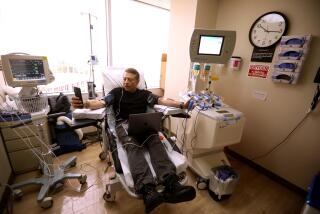Personalized care is the aim of more doctors
- Share via
SAN FRANCISCO — After practicing medicine for 25 years, Dr. Jeffrey Duckham was almost ready to hang up his stethoscope.
The high cost of maintaining a solo family practice coupled with low reimbursement rates from insurers required the Silicon Valley doctor to maintain a roster of 2,500 patients to stay in business. He couldn’t give people the time he thought they deserved -- or that his training taught him they needed, he said.
“Our whole office staff felt it was becoming more and more like a treadmill,” said Duckham, 56.
Unwilling to wait for a government fix, Duckham performed emergency surgery on his practice. He cut ties to insurance companies, slashed his caseload and began charging an annual fee for his services, following a growing number of fed-up primary care physicians into what’s come to be called “concierge medicine.”
As several states push plans for providing universal healthcare, concierge doctors nationwide are choosing to see fewer patients and focusing their professional skills on those who are willing to pay for more personalized care. The trend worries healthcare advocates who say it further divides the country into those who can afford good medicine and those who cannot.
But unlike the fee-for-service doctors of a decade ago who set out to serve a niche market of affluent consumers and charged up to $25,000 a year, today’s practitioners say they’re forging a free-market future that will save primary care medicine for everyone.
“We think that this is really a model that can transition to every primary care physician in the United States,” said Dr. Edward Goldman, co-founder of Boca Raton, Fla.-based MDVIP Inc., which franchises its concierge prototype to doctors like Duckham.
Under MDVIP’s plan, patients paying about $1,500 a year are guaranteed an annual 1.5-hour physical, a follow-up visit, a personal wellness plan and same- or next-day appointments lasting at least hour an hour. MDVIP physicians can have no more than 600 patients under their care at one time.
Concierge doctors say longer appointments give them the time to focus on illness prevention and early detection; it’s time they never had when they had to deal with HMOs and managed care plans.
The emphasis on preventive care saves the U.S. healthcare system money, say backers of concierge medicine, making their yearly fees look cheap by comparison.
Little data exists on whether concierge medicine actually produces healthier patients. It’s a question that could soon be on the minds of more consumers, with Procter & Gamble Co.’s recent purchase of a minority stake in MDVIP heralding a potentially big marketing push for concierge care.
Critics contend that by favoring wealthier patients who don’t have to rely on insurance, the rise of concierge practices merely pushes the United States closer to becoming a country where quality healthcare is available only to a wealthy few.
“This is basically the way medicine works in a Third World country. There’s no acknowledgment of any universal right to healthcare,” said David Barton Smith, a professor of healthcare management at Temple University.
Doctors with MDVIP say that, when broken down to dollars per day, their $1,500 annual fee costs little more than a daily espresso -- or a daily pack of cigarettes.
And, according to Goldman, the approach shows results, with hospital and emergency room visits down 50% to 70% among MDVIP’s 55,000 patients compared with those covered by traditional managed care plans.
Smith says those figures are skewed because customers who can afford concierge care already go to the hospital much less often than poorer patients, creating a self-selecting sample.
Whatever its value for patients, both critics and supporters agree that the rise of concierge medicine comes at a time when primary care in the U.S. is in crisis.
According to the American College of Physicians, which represents about 120,000 primary care physicians, an increasing shortage of general practitioners is forcing more patients on already overburdened doctors.
The deficit has been precipitated by the same stress and financial difficulties that drove Duckham into concierge medicine in the first place, according to a 2006 report by the doctors group.
Burned-out older doctors are retiring early, the report said, while new medical school graduates with huge student loan debts are favoring more lucrative specialties like cardiology and anesthesiology.
The concierge approach of trimming patient loads might seem likely to exacerbate the shortage of primary care doctors. But practitioners think less-hurried working conditions can attract new doctors to the field by showing them that primary care can still be practiced like the family doctors of old.
Dr. James Taylor of San Rafael became one of the Bay Area’s first concierge doctors when he opened his practice in 2003. (He said he preferred the term “retainer-based medicine,” adding that “concierge” implies his practice is only for the rich.)
Taylor, who follows the $1,500-a-year MDVIP model, has about 460 patients on his roster and sees eight to 12 a day, down from the 25 to 35 patients he saw in his old, conventional practice. His overhead consists of his small office in a chic Marin County loft, a receptionist and a physician’s assistant.
After covering costs, Taylor said he earned about $140,000 a year, slightly below the national average for a general practitioner and about half the average earnings for surgeons.
His patients are not “rich, old sick people” but mostly clients of modest means who are “sick and tired of being bounced around” during rushed appointments and receiving little personal attention, he said.
Taylor’s job satisfaction is higher too. It’s time with patients, not the money, that keeps him in the profession after 17 years.
“I feel more like a real doctor,” he said.
More to Read
Inside the business of entertainment
The Wide Shot brings you news, analysis and insights on everything from streaming wars to production — and what it all means for the future.
You may occasionally receive promotional content from the Los Angeles Times.










